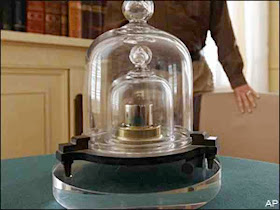The official kilogram, a cylinder of platinum and iridium maintained by the International Bureau of Weights and Measures, is more than 130 years old. It is stored under three glass domes in a safe in a basement in Sèvres, France, and can be accessed only with three independent keys.
Technically, the cylinder is not even the official kilogram until it has been cleaned in an authorized manner to remove contaminants. It is the only remaining international standard in the metric system that is still a man-made object. Some scientists now believe the official kilogram may be losing mass, which defeats its only purpose: constancy. This adds new urgency to a longstanding search for a new official kilogram, based, like the meter, on one of nature’s fundamental numbers, called constants. Over the years, the official meter has been redefined several times and is now “the length of the path traveled by light in a vacuum during a time interval of 1/299,792,458 of a second”. Though precise, it's not an everyday measuring stick.
The kilogram would be making the leap from the 19th Century to the present in a single jump, its only redefinition since 1889, when the first meeting of the General Conference on Weights and Measures was held. The trouble is that metrologists (scientists of measurement) don’t agree on what the new standard should be.
We reserve judgment, if only because the two possibilities, one based on Planck’s constant, the other on the Avogadro constant, each yielding a slightly different mass, fall well outside our competence. The hope, in which we heartily join, is that the kilogram will be redefined successfully in 2015, at the next meeting of the General Conference on Weights and Measures. Until then, we will just have to live with uncertainty.
09 February 2011
A kilo of coke won't do, apparently
An editorial in The New York Times discusses the official kilogram:


No comments:
Post a Comment
No more Anonymous comments, sorry.